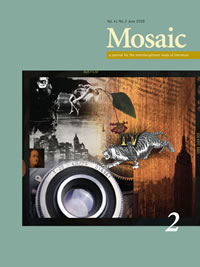Issue 41.2
Overview

General Issue
Published: June 2008
View the issue introduction or see the issue summary and contents below.
9 essays, totalling 192 pages
$19.95 CAD
Questions of memory are central to this issue, explored through intergenerational haunting, the poetry and photography of mourning, video recall, montage, survivor stories, and place theory. When and how is repetition/recycling revolutionary? The nine essays collected in Volume 41.2 link this question to that of the word-image relation. This is an issue in which hybridity is much in play.
Remembering Childhood: Critical Memory Through Text and Image in Miguel Gutiérrez's La destrucción del reinoMary Beth Tierney-Tello This essay analyzes the relationship between text and image in La destrucción del reino by Miguel Gutiérrez, with photographs by Julio Olavarría. The essay argues that the authors perform a critical type of memory work that allows their art, here photography and narration, to become a method for mourning and moving beyond the impasse produced by the guilt and the sense of loss experienced by the social subject in times of trauma. | |
The Empire State Building, Working-Class Masculinity, and King KongMerrill Schleier King Kong achieves mastery over Manhattan atop the Empire State Building before his ineluctable fall. This essay analyzes the Empire State Corporation’s textual and visual propaganda, much of which was displaced onto Kong, concluding that both giant ape and skyscraper were dual ciphers of the Depression era’s heroic and exploited multiethnic construction workers. | |
"A Just Image": Poetic Montage and Cuba's Special Period in La foto del invernaderoKristin Dykstra This essay explores La foto del invernadero, a book by Reina María Rodríguez, who recycles an array of materials in poetic montage. It gives special attention to two texts (one written, one visual): Camera Lucida and Guerrillero Heroico. The essay concludes with the poet’s questioning of revolutionary optics and generations. | |
Assassination on the Small Screen: Images and Writing in Ōe KenzaburōBruce Suttmeier This essay explores the status, form and phenomenology of images (largely televised images) in Ōe Kenzaburō’s 1961 two-part story “Seventeen,” a fictionalization of the famous 1960 political assassination of the Japanese Socialist Party Chairman that was captured on video and broadcast incessantly on national television. | |
Edith Sitwell's Carnivalesque Song: The Hybrid Music of FaçadeDebora van Durme For its public premiere at London’s Aeolian Hall in 1923, Edith Sitwell’s poetry cycle Façade, set to music by William Walton, was advertised as “A New and Original Musical Entertainment.” By examining Façade’s manifold links with art and popular music, this essay seeks to unearth the implications of that commercial catchphrase. | |
Bodies Electric: Gender, Technology, and the Limits of the Human, circa 1900Caleb Smith This essay considers the imagery of electrified female bodies in Henry Adams’s “The Virgin and the Dynamo,” Henry James’s “In the Cage,” and the case of Martha Place, the first woman executed in the electric chair. It explores how male authorities imagined the attractions and repulsions of an emergent, gendered “posthumanism.” | |
"The Strangest of Narrative Forms": Rodolphe Töpffler's Sequential ArtPhilippe Willems Rodolphe Töpffer changed sequential art forever by giving it unprecedented narrative resolution. An atypical cultural artifact within its own cultural environment, it has remained a problematic cultural object to name and define, its hybridity not just a factor of image and word but also of static and dynamic. | |
Trends in Literary Trauma TheoryMichelle Balaev This essay examines the dominant psychology model of trauma in literary criticism, especially intergenerational trauma theory, introducing alternative approaches for analysis of trauma in literature, including place theory. The essay analyzes the function of the traumatized protagonist in fiction and discusses the influence of place in the reformulation of the self. | |
Life as Pi as Postmodern Survivor NarrativeRebecca Duncan Although both popular and literary survivor stories have received critical attention for several decades, there has been little systematic contemplation of survival in a postmodern context. Yann Martel’s Life of Pi offers a fictional articulation of a postmodern identity as it shapes and is shaped by a narrative of trauma. |